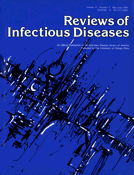-
Views
-
Cite
Cite
Shahe V. Komshian, Ahmad K. Uwaydah, Jack D. Sobel, Lawrence R. Crane, Fungemia Caused by Candida Species and Torulopsis glabrata in the Hospitalized Patient: Frequency, Characteristics, and Evaluation of Factors Influencing Outcome, Reviews of Infectious Diseases, Volume 11, Issue 3, May 1989, Pages 379–390, https://doi.org/10.1093/clinids/11.3.379
Close - Share Icon Share
Abstract
We reviewed 135 cases of candidemia occurring between 1983and 1986to examine oncologic and nononcologic populations and assess factors for survival. Candida albieans was the most common species (510/0); Candida tropicalis occurred most frequently in leukemia patients (57%), whereas Candida parapsilosis and Torulopsis glabrata were associated with solid tumors and nononcologic diseases. Risk factors identified were: preceding surgery, antibiotics, cannulas, and steroids in solid tumor and non oncologic diseases; and chemotherapy and neutropenia with hematologic malignancies. Even transient cannulaassociated candidemia was not a benign process. Intravenous cannulas werecommon portals of entry (39%) in debilitated patients without cancer (59%) and were associated with high mortality (55%). Overall mortality was 59%, candidemia directly contributing to death in 750/0 of cases. In patients with candidemia, failure to initiate therapy with amphotericin B had a negative influence on outcome, whereas analysis of the entire group identified severity of underlying illness as the dominant cofactor influencing outcome.







Comments